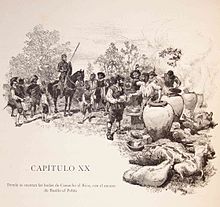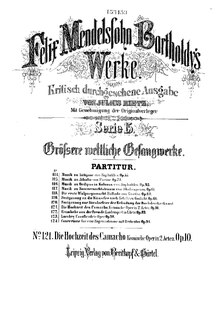Camacho's wedding
| Work data | |
|---|---|
| Title: | Camacho's wedding |

Piano reduction, 1828 |
|
| Shape: | Comic opera in two acts |
| Original language: | German |
| Music: | Felix Mendelssohn Bartholdy |
| Literary source: | Miguel de Cervantes : El Ingenioso Hidalgo Don Quixote de la Mancha |
| Premiere: | April 29, 1827 |
| Place of premiere: | Royal Theater Berlin |
| Playing time: | about 2 hours |
| Place and time of the action: | Spain in the 16th century |
| people | |
|
|
The Marriage of Camacho ( MWV L 5) is a play opera in two acts by Felix Mendelssohn Bartholdy . The first performance took place on April 29, 1827 in the Royal Theater in Berlin .
Emergence
In 1605 and 1615, Miguel de Cervantes published the two-part novel El Ingenioso Hidalgo Don Quixote de la Mancha . In the second part from the 19th chapter there is the story of the wedding of Camacho, in which the knight Don Quixote and his squire Sancho Panza are allowed to participate. The episode of the novel was adapted for the stage several times before and after Mendelssohn.
Mendelssohn's libretto also contains scenes from Don Quixote's adventure in the Montesino cave from chapters 22 and 23. Whose libretto Mendelssohn used is unclear, the libretto and the handwriting of the score are no longer available. Karl Klingemann or Karl August von Lichtenstein or Friedrich Voigts are named as librettists , Heinrich Eduard Jacob suspected that the polyphonic criticism of the libretto led to the fact that in the end no one acknowledged it out loud.
Ludwig Tieck had published a new translation of Don Quixote in Berlin at the turn of the century , Mendelssohn probably knew the book from his private teacher Karl Wilhelm Ludwig Heyse . Mendelssohn composed the opera between July 1824 and August 10, 1825. In 1826, at the insistence of his mother Leah , the opera was submitted to the Berlin Opera. In contrast to General Manager Carl von Brühl , General Music Director Gaspare Spontini was not very inclined to accept the work. The opera went into production and was premiered on April 29, 1827 with Heinrich Blume in the role of Don Quixote and Eduard Devrient as the tenant. It remained the only one of his four operas that was performed during Mendelssohn's lifetime. The play was not given on the big stage of the opera house , but on the more modest stage of the playhouse . Mendelssohn was dissatisfied with the performance, despite a sold-out house, and he did not allow himself to be invited on stage for the final applause. The audience received the opera with approval, but the press criticized the libretto, which had little impact on the stage. Further performances failed at first due to the illness of Heinrich Blum and other singers and then stopped completely. Mendelssohn's advocacy of this work was low, especially since he felt hurt by a criticism in a newspaper, and in the summer of 1826 he had started work on Midsummer Night's Dream . This may also explain why Mendelssohn's score for the opera was lost. What has been preserved, however, is the director's score from the hand of a Berlin professional copyist , which Mendelssohn revised considerably during the preparation for the performance. In 1828 Mendelssohn had Friedrich Laue in Berlin print a piano reduction of his early work. Julius Rietz published a score for the opera after 1874 as part of the complete edition of Mendelssohn's works for which he was responsible.
The opera was played very rarely later. In contrast, the overture is occasionally performed and is also distributed on phonograms.
action
The tenant Carrasco wants to marry his daughter Quiteria to the rich landowner Camacho, but she is in love with the poor student Basilio. The passing knight Don Quixote and his squire Sancho Panza are invited to the wedding party. Basilio conspires with Lucinda and Vivaldo to help prevent the marriage. Don Quixote, however, inadvertently interferes with him because of his eccentric behavior. Basilio has to flee from Carrasco and Camacho and his cousins, who want to fricass and massacre him.
At the wedding feast, dancers perform an allegorical dispute between Cupid and wealth . Basilio appears and appears to be stabbing himself with his sword. He asks "dying" to marry Quiteria, he cannot take his vows before that. Don Quixote's desire that the bridegroom could marry the widow on the following day, after Basilio's death, seemed reasonable. The priest performs the wedding and Basilio jumps alive from his deathbed. The so tricked Camacho finally comes to terms with Don Quixote's realization that a marriage with a woman who does not love him would not have been a joy, and allows the wedding celebration that he set up to continue. Don Quixote and Sancho move on.
Appearances
after the score by Julius Rietz at Breitkopf & Härtel
first act
- No. 1. Duet: Quiteria, Basilio Happy youth
- No. 2. Trio: Quiteria, Basilio, Carrasco How? you dare to measure it here
- No. 3. Aria: Basilio I am still comforted by the anticipation
- No. 4. Duet: Lucinda, Vivaldo So you return, beloved
- No. 5. Choir: Viva Camacho, viva Quiteria Carrasco: When loving and brooding
- No. 6th septet with choir: Quiteria, Lucinda, Basilio, Vivaldo, Camacho, Carrasco, Sancho Let me, o let me greet me again
- No. 7. Choir and aria: Sancho Viva Camacho, viva Quiteria , recitative: Basilio So I leave house and court
- No. 8. Aria: Quiteria Who knocks so softly on the door?
- No. 9. Ensemble: Camacho, Carrasco and their cousins The bones should fly in his body
- No. 10. Finale of the first act: Basilio, Quiteria, Camacho, Carrasco, Lucinda, Vivaldo, Don Quixote, Sancho, Chorus Let yourself be squirmed, dark cypresses ; Viva the erring knighthood!
Second act
- No. 11. Choir and aria: Sancho, Köche und Köchinnen Freshly just moved your hands
- No. 12. Song: Sancho, farmers and cooks The most beautiful bride in the whole country
- No. 13. Choir and Don Quixote; Ballet-Divertissement Bolero, Fandango Directing may decide the game ; Ha, tiger brood! Do you want to murder innocence?
- No. 14. Trio: Quiteria, Lucinda, Sancho What are the mysterious words supposed to mean to me?
- No. 15. Choir: Bridesmaids and Choirboys Now light consecrated candles
- No. 16. Ensemble: Quiteria, Lucinda, Vivaldo, Camacho, Carrasco and their cousins, Sancho, girls and women choir Which voice, which disturbance?
- No. 17. Finale: Camacho, Carrasco, Vivaldo, Basilio, Lucinda, Quiteria, Don Quixote, Sancho, choir How? cheated?
Performances / recordings
- 1988 Bernhard Klee , Berlin Radio Symphony Orchestra , RIAS Chamber Choir
- 1992 Jos van Immerseel , Anima Eterna Orchestra , The Young Choir Aachen . Channel Classics Records, Amsterdam 1993
- 2012 Vasily Petrenko , Royal Liverpool Philharmonic Orchestra at the European Opera Center
Other composers and choreographers
- Georg Philipp Telemann : Don Quixote at the wedding of Comacho , 1761
- Antonio Salieri : Don Chisciotte alle nozze di Gamace , 1770
- Louis Milon : Les Noces de Gamache , Ballet, Opera Paris, 1801
- Saverio Mercadante : Don Chisciotte alle nozze di Gamaccio , Cadiz, 1830
expenditure
- The Wedding of Camacho: Opera in Two Acts . Complete keyboard excerpt from the composer. Laue, Berlin 1828
- Camacho's wedding. Score. 1874-1882
- The wedding of Camacho , opera in 2 acts. Edited by Clive Brown [Soli, Choir, Orch]. Text: Carl von Lichtenstein and Friedrich Voigts. April 9, 2011 in Liverpool. At Breitkopf & Härtel , 2011 edition
literature
- Bárbara P. Esquival-Heinemann: Don Quixote in German-language opera . In: Tilmann Altenberg, Klaus Meyer-Minnemann (ed.): European dimensions of Don Quixote in literature, art, film and music . SUB Hamburg, Hamburg 2007, ISBN 978-3-937816-28-9 , pp. 235-261.
- Heinrich Eduard Jacob : Felix Mendelssohn and his time. Portrait and Fate of a Master . S. Fischer, Frankfurt am Main 1959.
- Wilhelm Adolf Lampadius: Felix Mendelssohn Bartholdy. A total picture of his life and work . Leuckart, Leipzig 1886.
Web links
- The Wedding of Camacho : Sheet Music and Audio Files in the International Music Score Library Project
- The wedding of Camacho , in the catalog of the HMT Leipzig
- The wedding of Camacho , synopsis at ckrumlov
Individual evidence
-
↑ Miguel de Cervantes Saavedra: Don Quixote of the Mancha. Translation of Susanne Lange . Volume 2. Hanser, Munich 2008.
Chapter XX tells about the wedding of Camacho the rich, along with the story of Basilio the poor and Chapter XXI continues with the wedding of Camacho, along with other tasty incidents , pp. 174–192 - ↑ Bárbara P. Esquival-Heinemann: Don Quixote in the German-language opera , 2007, pp. 253f.
- ↑ For Friedrich Voigts see Wikisource: Friedrich Voigts
- ↑ a b c d e Heinrich Eduard Jacob: Felix Mendelssohn , 1959, pp. 70–81
- ^ A b c Roland Dieter Schmidt-Hensel, Christine Baur: FELIX: Felix Mendelssohn Bartholdy for his 200th birthday . Carus, Stuttgart 2009, pp. 98f.
- ↑ Eduard Devrient : My memories of Felix Mendelssohn Bartholdy and his letters to me . Leipzig 1872, pp. 24-34
- ↑ No. 8 of the piano reduction from 1828
- ^ The wedding of Camacho , in the catalog of the HMT Leipzig


